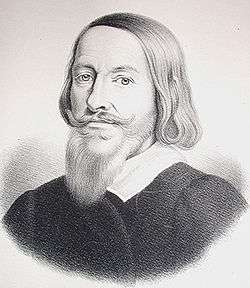Ove Gjedde
Ove Gjedde[1] (27 December 1594 – 19 December 1660) was a Danish nobleman and Admiral of the Realm (Rigsadmiral). He established the Danish colony at Tharangambadi (Danish: Trankebar) and constructed Fort Dansborg as the base for Danish settlement. He was a member of the interim government that followed the death of King Christian IV and which imposed restrictions (Haandfæstning) on his successor King Frederick III. [2] [3]

Early years
Gjedde was born at Tomarps (Tomarps Kungsgård) at Åstorp in Scania. He was the son of Brostrup Gjedde and Dorthe Pallesdatter Ulfeldt. He studied at Sorø Academy. He completed a tour to Germany and the Netherlands. Returning in 1616, he was appointed secretary of the Danish Chancellor.[4] [5] [6]
Career
In March 1618, Gjedde commanded an expedition to India and Ceylon to establish a Danish colony that could be used as a base for the China and East Indies trade of the Danish East India Company. His fleet consisted of the Danish naval ships Elefanten and David, the yacht Øresund, and the merchant ships Kiøbenhavn and Christian. [7] He established Fort Dansborg at Tranquebar, which would remain a Danish colony for 200 years. Gjedde returned in March 1622 and was appointed lord of Brunla len (now in Akershus). In 1637, he received Tønsberg len (now Vestfold).[8]
Gjedde acquired land properties in Norway, and was a central participant in the mining industry. In 1657, he established the iron foundry Ulefos Jernværk at Ulefoss in Nome, together with Preben von Ahnen. From 1630 he was director of the Kongsberg Silver Mines. [8]
In 1628, he was appointed Lieutenant Colonel of Akershus Regiment. He participated in the Torstenson War (1643–1645) as an admiral and in 1645 he was made Admiral of the Realm (Rigsadmiral). In 1648 he was granted the fiefdom of Helsingborg Castle. [9]
Later years
After the peace in Roskilde, Denmark lost Scania to Sweden. When king Charles X Gustav of Sweden broke the peace of 1658, Ove Gjedde was taken prisoner, during a visit to Helsingborg. He was first sent to prison in Helsingborg castle, and later sent to Malmö. In 1660 he was released during prisoner exchanges between Sweden and Denmark. At the time Gjedde was an old and physically weak man and he had already built a grave monument in the old Danish city of Helsingborg, which had now become Swedish. The legend says that, "His bones after the Roskilde peace never found rest, after Scania became Swedish" (Danish: hans ben efter Roskildefreden fandt aldrig hvile, efter Skåne var blevet svensk). Gjedde died at Copenhagen in 1660.[5]
Personal life
In 1622, Gjedde married Dorothy Knudsdatter Urne (1600-1667), daughter of Knud Axelsen Urne til Årsmarke (1564–1622) and Margrethe Eilersdatter Grubbe til Alslev (1568–1654). His wife was a sister of Christoffer Urne (1593–1663) who served as Steward of Norway. They were the parents of several children including Knud Ovessøn Gjedde and Brostrup Gjedde both of who served as County governors in Norway. [8] [10] [11] [12]
- Dorte Gjedde (1625-?) - daughter
- Brostrup Gjedde (1628–1668) - son
- Margrethe Gjedde (16??-1706) - daughter
- Merete Gjedde (16??-1689) - daughter
- Regitze Sophie Gjedde (1634-1653) - daughter
- Knud Ovessøn Gjedde (1635-1708) - son
- Frederick Eiler Gjedde (1641-1717) - son
See also
References
- Also written Ove Gedde and Ove Giedde
- "Ove Gjedde". lokalhistoriewiki.no. Retrieved January 1, 2019.
- "Haandfæstning". guideservicedanmark.dk. Retrieved January 1, 2019.
- "Historia". Tomarps Kungsgård. Retrieved January 1, 2019.
- Jørgen Marcussen. Ove Gjedde - Admiral, 1594-1660 (in Danish)
- Erik Opsahl. "Ove Gjedde". Store norske leksikon. Retrieved January 1, 2019.
- Charukesi Ramadurai. Trankebar
- Rian, Øystein. "Ove Gjedde". In Helle, Knut (ed.). Norsk biografisk leksikon (in Norwegian). Oslo: Kunnskapsforlaget. Retrieved 6 January 2014.
- Th. Topsøe-Jensen. "Ove Gjedde". Dansk Biografisk Leksikon, Gyldendal. Retrieved January 1, 2019.
- "Gedde" (in Danish). RoskildeHistorie.dk. Retrieved 2018-12-05.
- Ranveig Gausdal. "Christoffer Urne". Norsk biografisk leksikon. Retrieved January 1, 2019.
- "Brostrup Gjedde". lokalhistoriewiki.no. Retrieved January 1, 2019.
External links
- Ove Gjedde Trankebar Net
- Om Ove Gieddes ekspedition til Ceylon og Tranquebar 1618-1622 Danmarks Historien